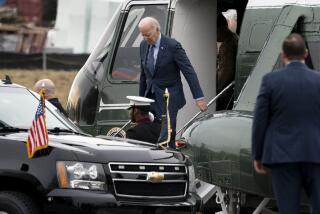U.S. to Apologize to Some Victims of Radiation Tests : Research: A few dozen subjects of the most harmful experiments, or their families, could get compensation. Government secretly funded projects.
- Share via
WASHINGTON — A presidential advisory committee will recommend today extending an official apology and financial compensation to just a handful of the thousands of Americans who were unwittingly exposed to radiation in secret government-sponsored experiments in the years after World War II.
The committee studied nearly 4,000 experiments. But it concluded that only three, involving no more than a few dozen subjects, raised legal and ethical concerns severe enough to warrant offering apologies and compensation.
Although criticizing the conduct of federal officials and others involved, the commission concluded that apologies and compensation were not appropriate in most cases because most of the experiments--conducted between 1944 and 1974--posed little danger to participants.
The panel said it believed that people who were used as research subjects without their consent “were wronged, even if they were not harmed.”
But it said it was “not persuaded that . . . financial compensation is necessarily a fitting remedy when people have been used as subjects without their knowledge or consent but suffered no material harm as a consequence.”
An apology and compensation were called for, the report said, in instances where information about the experiment was kept from subjects for the purpose “of avoiding embarrassment,” or potential legal liability, “and where this secrecy had the effect of denying individuals the opportunity to pursue potential grievances.”
Among the cases meeting this standard were those involving individuals used in experiments that offered “no prospect of direct medical benefit,” and where injury from the experiments resulted.
Specifically, the panel recommended that apologies and compensation go to the families of 18 hospital patients, most of whom were terminally ill at the time, who were unknowingly injected with plutonium between 1945 and 1947.
The committee also recommended that several subjects of total body irradiation experiments conducted during World War II, and the subject of a zirconium injection experiment, known only as Cal-Z, be included.
Noting that these cases have had a lasting impact on the country as a whole even though they occurred decades ago, the commission said: “The greatest harm from past experiments and intentional releases may be the legacy of distrust that they have left.”
Hundreds of intentional releases of radiation “took place in secret, and remained secret for decades,” the report said, and information about human experiments was kept secret “out of concern for embarrassment to the government, potential legal liability and worry that public misunderstanding would jeopardize government programs.”
The work began at a time during World War II when many such studies were undertaken in secret to help understand radiation risks to workers involved in the development of the atomic bomb. This was long before it became standard practice to issue “informed consent” to medical research subjects, laying out the risks and benefits of participation.
“It was commonplace during the 1940s and 1950s for physicians to use patients as subjects of research without their awareness or consent,” the report said.
Federal investigators are “blameworthy” for not having had policies in place to protect subjects used in research who could not have medically benefited from the work, the panel said. Researchers were “less blameworthy” in instances where they believed the experiments might be therapeutic, the group added.
The plutonium experiment, for example, was designed to determine how much of the substance remained in patients’ bodies after exposure. It was deemed necessary at the time to assess the risks that workers faced when exposed to such materials.
One patient was injected at Oak Ridge Hospital in Oak Ridge, Tenn.; 11 at the University of Rochester, N.Y.; three at the University of Chicago, and three at the University of California.
The report said panel members “struggled” with the question of when to recommend that the government extend an apology to individuals, but said their deliberations were complicated by “a murky historical record” where, in a majority of cases, “there was simply too little documentary evidence” to determine whether there was informed consent.
The panel recommended changes in informed consent procedures of today, saying they should more realistically reflect the expectations of the experimental therapies involved. Also, the panel said sometimes the informed consent documents are “incomprehensible” to lay people and should be improved.
Its members focused on eight different categories of radiation experiments. These included the plutonium experiments and others involving materials used in atomic bombs; non-therapeutic research on children; total body irradiation; research on prisoners; the Atomic Energy Commission program of radioisotope distribution; human experimentation in connection with nuclear weapons testing; intentional environmental releases of radiation, and observational research involving uranium miners and residents of the Marshall Islands, who were exposed to radiation from nuclear tests.
The period of the experiments encompassed both the birth of the new field of radiation science and the evolution of more sophisticated concepts of biomedical ethics to protect human research subjects.
The experiments ended during a watershed year when the government recognized the need to protect human subjects, and established regulations that governed the conduct of human research.
The majority of experiments identified by the panel involved radioactive tracers administered in amounts similar to those used in research today.






